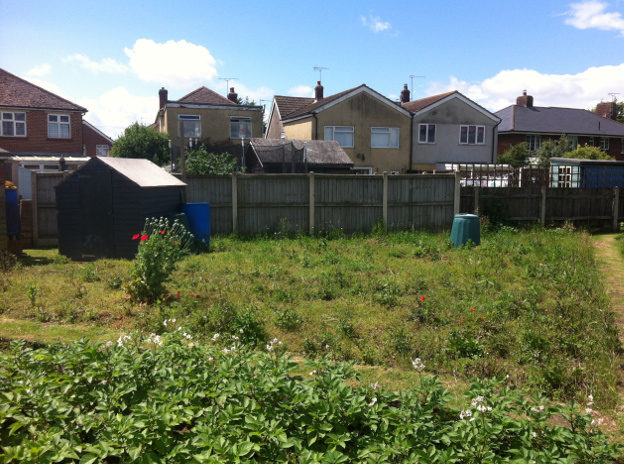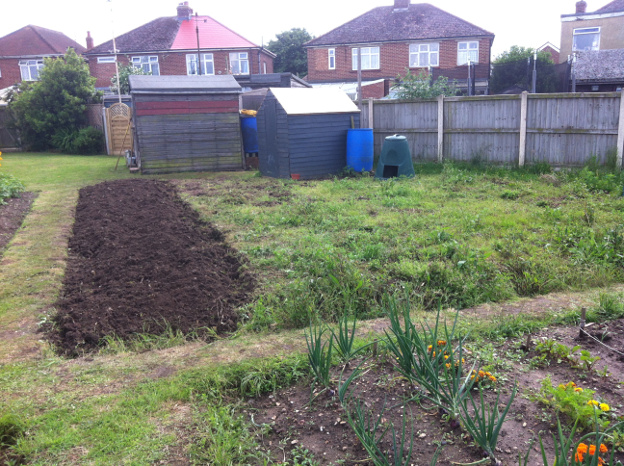There has been an exciting development for us and our fruit and vegetable growing. We’ve got an allotment! It’s something we had considered for some time. We thought about it a lot before we moved into our current house. But once we moved here and had more growing space than ever before, we were in our element and the idea of an allotment became less important.
Of course more space would have been nice. Just a few weeks ago I commented in a post that due to our crop rotation plan and the size differences between our beds we wouldn’t be able to grow as many squashes this year. An allotment would solve that! But we still had almost enough space here and we were put off of the allotment idea by the long waiting list. My dad was on the waiting list for years before he finally got his about eighteen months ago.
But in April I spotted an advert in the local newspaper which said that some plots were expected to become available soon and to enquire at the council office if interested. Liz and I discussed it and decided to apply, expecting that we would still be on a long list of applicants. But to our surprise, two months later and we have one!
It’s not a very large one, just three rods (more on that later). It appears that in recent years many plots have been divided into multiple smaller plots, presumably to bring the waiting list down. According to The National Allotment Society, the standard allotment size is 10 rods. By that definition we have just under a third of one.
But in our case a smaller plot isn’t a problem, since we grow a lot in our garden anyway, this isn’t our only growing space. It probably would be a bit small for someone who had nowhere else to grow.
What is an allotment?
We know from the information provided by Google Analytics that a lot of our readers aren’t reading from the UK. A quick search online suggests that different countries have different names for what we call an allotment. So for the benefit of those who call it by another name, here is a quick overview:
What we call an allotment in the UK is often called a ‘community garden’ in the US. It is a plot of land usually provided by the local authority for the tenant to cultivate in exchange for a low rent. This plot of land is usually part of a large allotment field which has been subdivided into multiple plots.
What are rods?
A rod is a unit of measure used exclusively for the measurement of land. It is a very old unit of measure that was commonly used by the early Anglo Saxons. It is the equivalent to 16 ½ modern feet (5 ½ yards, just over 5 metres). Other names for the same length are ‘perch’ and ‘pole’.
Historically it was a very useful measurement of land because whole number multiples of it make up the area of a ‘perfect’ acre in the context of a strip field farming system. A perfect acre would be 40 rods long by 4 rods wide (660’ x 66’). It is rarely used as a unit of measure in the UK any more, but it is still used when referring to allotment plot sizes.
Our Allotment Plot
Our allotment is on a site just a few minutes’ walk from our house. It came with a fairly sturdy shed, a water butt and two compost bins. The shed is in quite good condition, but the roof has no felt on it. The previous tenant left some guttering inside the shed, which he was going to connect to the water butt. So felting the roof and putting up the guttering are jobs that we plan to undertake very soon. We’ve had so much rain lately, and there’s more forecast. We would be wise to do both as soon as possible.
When my dad got his allotment (which is on the same site) it hadn’t been cultivated for some time and it was overrun with perennial weeds. I helped him to prepare the soil and it was hard work. But we have been very fortunate as we have received our plot in much better condition. The previous tenant neglected it, but the tenant before that took very good care of it. So preparation of the beds won’t be anything like as hard work as my dad and I faced on his plot.
So yesterday we worked on our new allotment for the first time. We were there for a few hours, a lot of that time was spent speaking to the tenant of a neighbouring plot, who has been working plots on the site for over 50 years! He appears to be very knowledgable, and I’m sure his experience and knowledge of the site (he had our plot as well as several others at one point), will benefit us greatly.
As well as talking to our new allotment neighbour, and shepherding our children back onto our plot when they wandered astray, we also managed to get some of the plot ready for planting. Our vision for the plot involves four beds with two larger ones and two smaller ones, due to the shed eating into the available land, and the slightly irregular shape of the plot. Based on this vision, we cleared half of each of the two larger beds. The soil is very light, it should be a joy to work with.
Back in the spring when we were sowing seeds for our garden, we sowed a lot more leeks, celeriac, calabrese and purple sprouting broccoli than we had room for. We have kept many of these in holding with a view to planting them out as and when space became available. When we sowed them we had no idea that we’d have an allotment this year, so it wasn’t by design. But I’m now thankful that we did get a surplus of these plants, as the time of year that we have received the allotment limits what we can still sow this season.
So this evening my dad gave me a hand to get planting. We planted out some of the leeks, calabrese and purple sprouting broccoli. My dad also donated some swedes that he had sowed in paper pots. I also managed to prepare most of the rest of the larger two beds, so I’m now ready to return with the celeriacs (which are also in paper pots). It really feels like it’s taking shape already, after just a few hours’ work. There’s still much to be done though.
So that’s our exciting news. We’ll be sure to keep you updated on our progress. In fact we’ve decided to post our growing updates more frequently. We’ve been somewhat sporadic in posting them up to now, but from now on we’re going to aim to post at least one a month, probably more in the busier months. So be sure to check back regularly to see how we are getting on.



